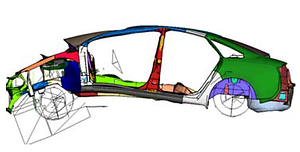New concepts for test and FE analysis data comparisons
1
General Manager, vMACH Engineering, GERMANY
2
Poznan University of Technology, POLAND
Publication date: 2009-02-02
Rail Vehicles/Pojazdy Szynowe 2009,1,44-53
ABSTRACT
The paper proposes usage of existing methods of test data analysis into post-processing of FE
models results, as well as usage of improved methods of FE data identifications for test data
analysis. Continuously growing size and complexity of the FE models and possibilities of new
technologies like laser or camera measurement of vibrations need new methods in
identification, comparison and correlation. Generalised workflow of NVH analysis and 18
steps of proposed methodology are presented. Every step is described using graphics pictures
generated from FEgraph software dedicated as post-processing tool for automotive industry.
The proposed methods of same data processing for test and analysis data was successfully
introduced into automotive industry and is on continuous development. Nevertheless, it can be
used in the other branches of industry including in the analysis of the strength calculations of
the rail vehicles bodies.
REFERENCES (18)
2.
HEYLEN W., LAMMENS S., SAS P. : “Modal Analysis Theory and Testing”, Katholieke Universiteit Leuven, Departement Werktuigkunde, Leuven, 1997.
3.
GRAFE H.: “Model Updating of large Structural Dynamics Models Using Measured Response Function”, PhD. Thesis, Imperial College of Science, Technology and Medicine, Mechanical Engineering, London, UK, 1998.
4.
IMAMOVIC N.: “Validation of large structural dynamics models using modal test data”, PhD Thesis Imperial College of Science Technology and Medicine, London, UK, 1998.
5.
REZA ASHORY M.:“High Quality Modal Testing Methods”, PhD Thesis Imperial College of Science Technology and Medicine, London, UK, 1999.
6.
VON MACH A.: “Identification of large FEModels”, MSC German Users' Conference, 2003.
7.
DOMOK S., VON MACH A. ,MERK J.: “FE-OPTIM and MSC/NASTRAN for a Frequency Response Optimization”, MSC Americas Users' Conference, 1998.
8.
VON MACH A., NOWAK D.: „Balken Pre- und Postprozessor für MSC/NASTRAN feprofil-Querschnitt -Berechnung febeam -Balkensyteme Analyse“, MSC Anwenderkonferenz München 1996.
9.
VON MACH A.: “Modal identification of quasisymmetric structures with an example taken from vehicle body models”, FENET/NAFEMS Seminar FEM in Structural Dynamics Wiesbaden, 14.-15. 11.2001.
10.
ROSE T.: “Using strain energy to identify modal participation in a dynamic response analysis”, The MSC World’s Users’ Conference, Los Angeles, 1994.
11.
WAMSLER M., ROSE T.: “Improved identification of contributing modes in superelement modal frequency response analysis”, The MSC Americas Users’ Conference, Universal City, 1998.
12.
WAMSLER M., ROSE T.: “Advanced mode shape identification method for automotive application via modal kinetic energy plots assisted numerous printed outputs”, The Americas Users’ Conference, Universal City, 1998.
13.
BALASUBRAMARIAN B., WAMSLER M.: “Identification of contributing modes in MSC/NASTRAN modal frequency response analysis”, MSC European Users’ Conference, 1987.
14.
KALINSKI K., VON MACH A.: “Modal energy identification of FE large structures”, International Conference on Noise and Vibration Engineering ISMA Leuven, 2002, 589-598.
15.
SUTTER T.R., CAMARDA C.J., WALSCH J.L., ADELMAND H.M.: “Comparison of Several Methods for Calculating Vibration Mode Shapes Derivatives”, AIAA Journal Vol .26 No.12, 1988.
16.
NELSON R.B.: “Simplified Calculation of Eigenvector Derivatives”, AIAA Journal, Vol.14, No.9 1976.
17.
VON MACH A., UHL T.: “Modal identification of quasi-symmetric structures with an example taken from airplane airframe models”, 3rd Worldwide MSC Aerospace Conference Toulose, 2000.
18.
FRISWELL M.I., MOTTERSHEAD J.E.: “Finite Element Model Updating in Structural Dynamics”, Kluwer Academic Publishers, 1995.
We process personal data collected when visiting the website. The function of obtaining information about users and their behavior is carried out by voluntarily entered information in forms and saving cookies in end devices. Data, including cookies, are used to provide services, improve the user experience and to analyze the traffic in accordance with the Privacy policy. Data are also collected and processed by Google Analytics tool (more).
You can change cookies settings in your browser. Restricted use of cookies in the browser configuration may affect some functionalities of the website.
You can change cookies settings in your browser. Restricted use of cookies in the browser configuration may affect some functionalities of the website.



